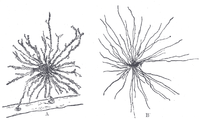
Photo from wikipedia
The development of in vitro assays for 3D microenvironments is essential for understanding cell migration processes. A 3D‐printed in vitro competitive radial device is developed to identify preferred Matrigel concentration… Click to show full abstract
The development of in vitro assays for 3D microenvironments is essential for understanding cell migration processes. A 3D‐printed in vitro competitive radial device is developed to identify preferred Matrigel concentration for glioblastoma migration. Melt electrowriting (MEW) is used to fabricate the structural device with defined and intricate radial structures that are filled with Matrigel. Controlling the printing path is necessary to account for the distance lag in the molten jet, the applied electric field, and the continuous direct‐writing nature of MEW. Circular printing below a diameter threshold results in substantial inward tilting of the MEW fiber wall. An eight‐chamber radial device with a diameter of 9.4 mm is printed. Four different concentrations of Matrigel are dispensed into the radial chambers. Glioblastoma cells are seeded into the center and grow into all chambers within 8 days. The cell spreading area demonstrates that 6 and 8 mg mL−1 of Matrigel are preferred over 2 and 4 mg mL−1. Furthermore, topographical cues via the MEW fiber wall are observed to promote migration even further away from the cell seeding depot. Previous studies implement MEW to fabricate cell invasive scaffolds whereas here it is applied to 3D‐print in vitro tools to study cell migration.
Journal Title: Advanced Biosystems
Year Published: 2020
Link to full text (if available)
Share on Social Media: Sign Up to like & get
recommendations!